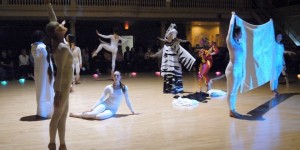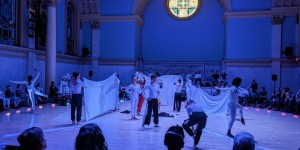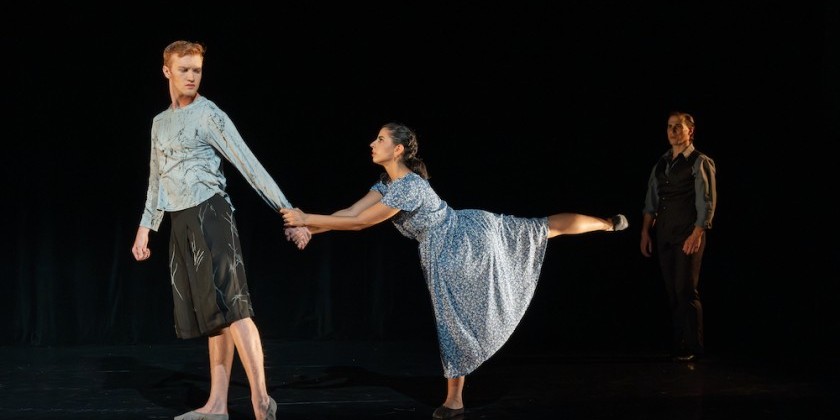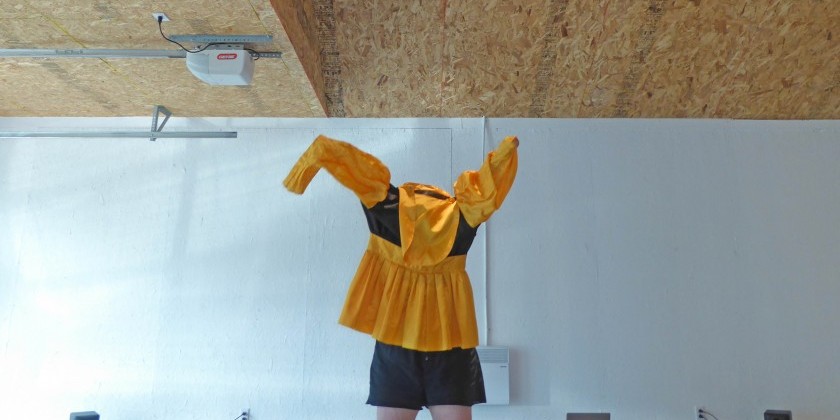IMPRESSIONS: Douglas Dunn Hosts a Garden Party

Douglas Dunn + Dancers presents GARDEN PARTY
Steps: Douglas Dunn
Set and Costumes: Mimi Gross
Illumination: Lauren Parrish
Sound Design: Jacob Burckhardt
Pre-Show Live Music: Tosh Sheridan
Dancers: Alexandra Berger, Janet Charleston, Grazia Della-Terza, Douglas Dunn, Vanessa Knouse, Emily Pope,
Paul Singh, Jin Ju Song-Begin, Timothy Ward, and Christopher Williams
Venue: Douglas Dunn Studio, 541 Broadway, New York, NY
Dates: April 24 - 30, 2023
Douglas Dunn’s extraordinary and peculiar new dance, Garden Party, a pinnacle in his accomplished career, offers a poignant love letter to Grazia Della-Terza, his lifetime partner, to his company, and to the audience. The superb performers, Alexandra Berger, Janet Charleston, Grazia Della-Terza, Vanessa Knouse, Emily Pope, Paul Singh, Jin Ju Song-Begin, Timothy Ward, Christopher Williams, and Dunn, and set designer, Mimi Gross, longstanding members of Douglas Dunn + Dancers, are deeply aligned with the choreographer’s aesthetic. As a result, for 65 minutes the elements seamlessly come to fruition in a Gesamtkunstwerk.

Dunn's loft space quivers with fecundity, tranformed by Gross into a psychedelic world of painted flowers. The mirror, extending along the upstage wall, is painted with a cosmic Fauve-flavored landscape. The shifting and evocative "illumination" (program byline) by Lauren Parrish causes fluorescent areas to pop, along with aspects of the landscape, and the outlines of the costumes. These moments make the senses tingle. The side areas of the stage, one side mimicking a hedgerow ramp, are painted with an abundance of flowers to create a magical opera-like surround-set.
The dancers shimmer in beautifully distinctive costumes, also by Gross. Expressing the personality of each dancer, they range from sleek, muted leotards and body-hugging two-pieces, to bright unitards and velvet capes, sheer wraps, see-through tutus, and Fortuny skirts in different lengths and styles. As the dancers cavort through the garden they layer and remove costumes.

Dunn takes his place upstage, behind a pulpit-like construction covered in painted rhododendrons. Dressed in a lime green top with multiple attached flapping leaves, and a multi-colored beanie, Dunn, the maestro, the clergy, attentively watches, listens, and periodically comments on the movement. At intervals, he steps from behind his pulpit to execute a series of bouncing, small leg crosses, backward jigs, and shifts of weight.
A dancer with Merce Cunningham in the early 1970s, Dunn bases his movement vocabulary primarily on Cunningham's rigorous, precise, and spatial technique. A soupçon of Baroque dance is evident, too. Dunn was also a member of The Grand Union, an improvisational, subversive, watershed dance group. Comfortable in divergent worlds, Dunn develops strictly defined choreography (perhaps, at times too measured), underpinned by play and sly whimsy.

An opening solo danced by Ward, that includes a slow arabesque promendade into a quick slice of the leg behind the knee is accompanied by Ibn Hazm's verses, "Is there no way I might/Open my heart with a knife/I could slip you in/And close the cut again." Enter Song-Begin, Pope, Berger, and Knouse. Evenly spaced in a line downstage, they lower themselves to the floor, and sit with bent legs, their backs to the audience, arms extended upward, and spines curved sideways. Singh, Charleston, and Williams process slowly in a line upstage. They pause in front attitude looking out at the audience. Feet flick before they lunge forward. The downstage and upstage lines cross. A rhythmic 1,2,3 phrase contrasts with turns in attitude.
Dancers are often paired. Four duets, dancers facing one another, formally bend, rise, and sustain movement. They change places and turn on relève, a leg extending. Charleston and Berger, in unison, execute little gallops to a kneeling position.
Della-Terza, a gracious, gray-haired dancer in a light dotted dress, sways assuredly to a recording of her own trembling voice reciting Rainer Maria Rilke's Duino Elegies poem: "However mysterious death is, life is all the more so." Appearing periodically throughout the dance, Della-Terza acts as a benevolent guardian.

Images of birds abound in poetry, sound, and movement: a nightingale, a dove, an owl, an eagle. John Milton's verses, "O Nightingale, that on yon bloomy Spray...Portend success in love...that amorous power to thy soft lay," read by Dunn, accompanies his mincing traverse of the mirror to a white garden bench. At one hilarious and unexpected moment, Dunn, who is seated behind his pulpit, slowly lifts a giant, stuffed, surprise-eyed bluebird that seems to perch and sing.
In a nod to Merce, a portable barre painted green is carried onto the stage. Williams and Singh remove their white Fortuny skirts, fold them, and then curiously hang out at the barre bare-bottomed until they dress again, and exit. Toward the end of the dance, Dunn and Dell-Terza agreeably sit on the bench to tend to their flock. Together, they get up and dance in front of the bench to the lyrics, "You think I don't love you, oh, but I do...I know that it's you I love," from The Time, the Place, and the Girl, a 1946 film. Finally, accompanied by Bach's St John Passion, with Della-Terza observing, Dunn, on the floor facing downward, a long leg behind, awaits the dancers, who, balancing upside down, fold to the floor to join him. As they rise, the lights fade. With this rise we know Dunn, the dance poet, will continue to delight.












